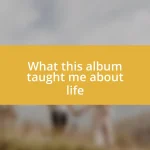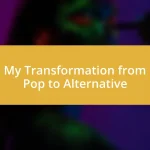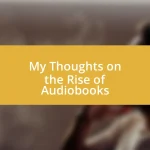Key takeaways:
- Multi-author collaborations enhance creativity by blending diverse writing styles, expanding audience reach, and fostering shared learning experiences among authors.
- Challenges in multi-author projects include maintaining consistent tone, managing creative ownership, and coordinating schedules among participants.
- The future of multi-author genres may be shaped by technology, reader involvement in storytelling, and the incorporation of diverse cultural backgrounds in narratives.

Understanding Multi-Author Trends
In understanding multi-author trends, I often find myself reflecting on the collaborative spirit that such ventures embody. For instance, when I participated in a multi-author anthology, it was fascinating to witness how each writer’s unique voice meshed into a harmonious collection, revealing unexpected themes and connections. Have you ever felt that electric buzz when different perspectives come together? It’s like a creative symphony.
The rise of multi-author projects can also be attributed to the way they tap into diverse audiences. Personally, I’ve seen how collaborations can breathe new life into genres by blending styles and ideas. Remember that genre mashup you read that knocked your socks off? Those moments highlight how different authors can challenge conventions and expand readers’ horizons while pulling in fans from various backgrounds.
I often think about the emotional journey behind these trends. Writing alongside others can feel like a double-edged sword; there’s joy in sharing and learning, but also trepidation about standing out. Have you ever questioned your place in a group? It’s moments like these that can truly push an author to evolve, fueling both individual creativity and collaborative innovation.

Benefits of Collaborating with Authors
Collaborating with other authors can unlock a wealth of creativity that often exceeds what one might achieve alone. I remember working alongside a seasoned novelist on a project; their storytelling techniques opened my eyes to new narrative structures I had never considered. That experience ignited a passion in me to experiment with my writing style, proving how collaboration can ignite personal growth and innovation.
Benefits of Collaborating with Authors:
- Diversity of Ideas: Collaborations result in a rich tapestry of perspectives, inspiring out-of-the-box thinking.
- Expanded Audience Reach: By joining forces, authors can access each other’s fan bases, broadening their readership.
- Shared Learning Experience: Each author brings unique skills to the table, providing an opportunity to learn and refine techniques.
- Increased Motivation: Writing alongside others fosters accountability and can spark motivation, making the creative process more engaging.
- Enhanced Support System: Collaboration builds a network of support, offering encouragement through the ups and downs of the writing journey.
I often find that the emotional support received during these collaborations is invaluable. The shared highs and lows create bonds that not only enhance my writing but also my perspective on what it means to be part of a community. Collaboration transforms solitary work into a shared adventure, reminding me that, in many ways, we are stronger together.

Exploring Genre-Specific Collaborations
Exploring genre-specific collaborations opens up a fascinating world of creativity. I remember the thrill I felt while collaborating on a sci-fi project where we combined our stories into a single universe. It was incredible to see how each writer’s take on futuristic elements added layers of depth and excitement to our narrative. Have you ever thought about how a different writing style can transform a genre? The interplay of distinct voices within the same genre can reveal new dimensions, making the final product much more expansive than if written by one author alone.
In romance collaborations, I have experienced firsthand the richness that diverse styles bring to intimate storytelling. Collaborating with authors who focus on different aspects of love—be it contemporary, fantasy, or historical—allowed us to craft a multi-faceted exploration of relationships. I still cherish nights spent brainstorming character arcs and how emotional intricacies could weave through various timelines. Each discussion pushed me to think deeper about love’s different expressions, ultimately broadening my own approach to writing.
When it comes to mystery genres, blending plots with other authors can yield unexpected twists that keep readers guessing. I once teamed up with a crime writer, and together, we created a narrative that combined elements of thrillers and psychological suspense. It felt like dancing on a knife’s edge, with each plot twist emerging from the chemistry of our ideas. Have you ever felt that rush of adrenaline when you unravel a mystery? That collaboration not only invigorated my storytelling but helped me understand the intricate art of suspense in a way I hadn’t comprehended before.
| Genre | Collaboration Benefits |
|---|---|
| Sci-Fi | Combining unique futuristic ideas enhances world-building and depth. |
| Romance | Diverse styles create nuanced explorations of love and character relationships. |
| Mystery | Unexpected plot twists arise from merging different writing approaches. |
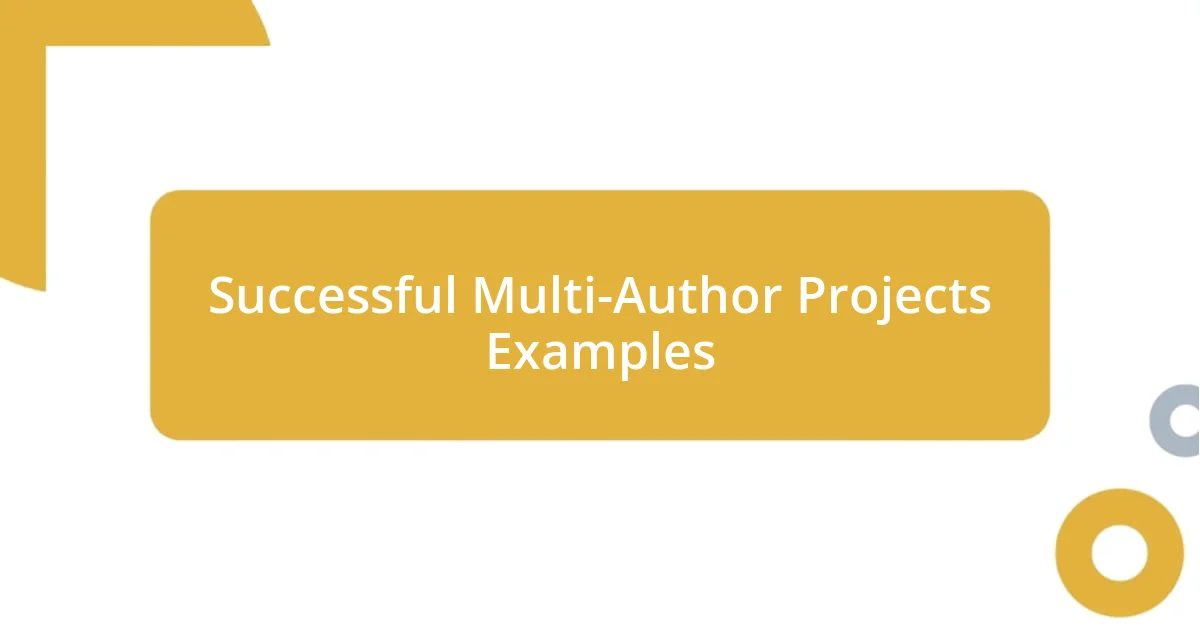
Successful Multi-Author Projects Examples
One of the most notable examples of successful multi-author projects is the The 1001 Nights anthology. Here, writers from various backgrounds contributed their unique spins on classic tales, weaving together different narratorial techniques and cultural influences. I remember getting lost in this collection, realizing how each author’s voice added a vivid texture, transforming familiar stories into something that felt entirely fresh. Isn’t it surprising how the melding of diverse storytelling styles can breathe new life into traditional narratives?
Another striking example is the Book of Heroes project, where writers from different fantasy realms collaborated to create interconnected stories about legendary figures. I participated in a similar initiative, and it was exhilarating to see how my peers interpreted heroism through their own lenses—some wrote about epic battles, while others focused on personal struggles and growth. This depth of understanding made me reflect on what truly defines a hero. Have you ever thought about how many facets there are to the idea of heroism?
Looking at the Writers’ Guild of America, they often organize multi-author anthologies that spotlight social issues through fiction. I took part in one that tackled climate change, and it was a powerful experience to see how my fellow authors crafted hope and urgency in their narratives. Each story resonated with the notion that, while our styles differ, we share common concerns that shape our writing. It’s incredible how collaboration can amplify these important messages, don’t you think?
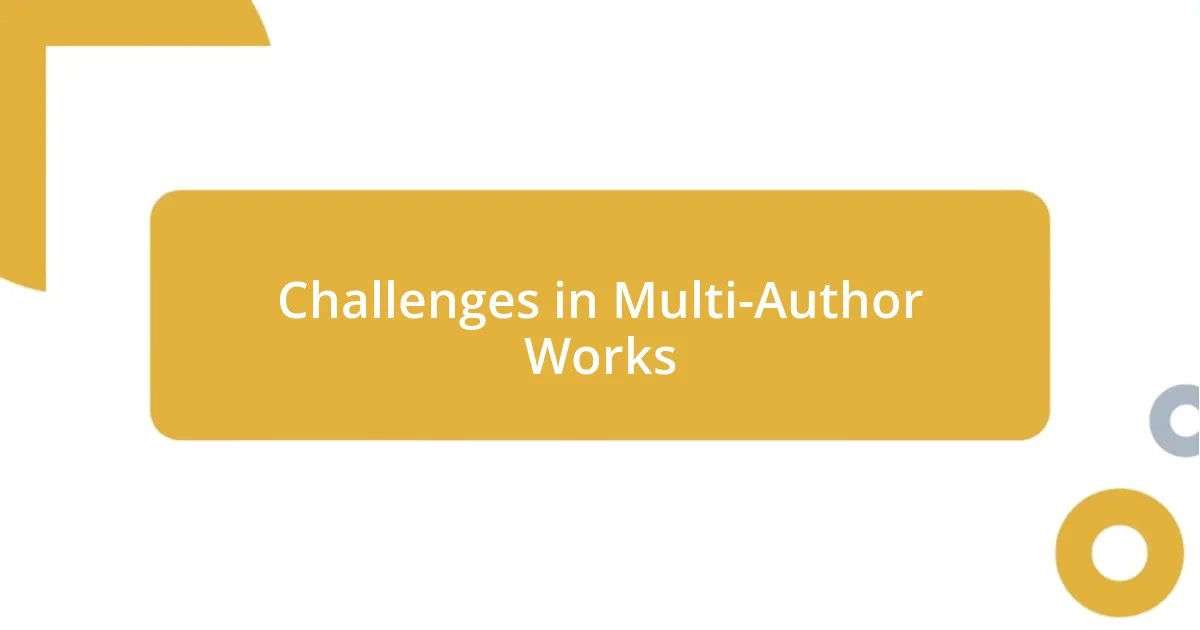
Challenges in Multi-Author Works
When it comes to multi-author projects, one of the challenges I often face is maintaining a consistent tone throughout the narrative. I once found myself collaborating on a fantasy series, and while each author brought unique strengths to the table, weaving our different writing styles seamlessly proved to be quite the task. Have you ever tried to harmonize contrasting voices? It can feel like trying to play a symphony with instruments that don’t quite match!
Another issue that pops up surprisingly often is creative ownership. In a recent collaboration, my co-authors and I had passionate debates about plot directions and character development. I felt strongly about a character arc, but others disagreed, leading to moments of friction. Has that ever happened to you in a group project? It made me realize how crucial it is to establish clear agreements upfront to ensure everyone’s vision is respected while fostering a cohesive product.
Lastly, coordinating schedules can become a significant hurdle. I vividly remember a project where our timelines collided, leading to rushed writing and last-minute edits. It left me wondering, how can we effectively juggle individual commitments while contributing to a collective goal? It’s essential to develop a flexible timeline and prioritize communication, so that everyone stays on the same page while navigating their own writing journeys.

Marketing Strategies for Collective Works
When marketing collective works, tapping into the unique strengths of each author can significantly enhance visibility. I recall a project where we collaborated on a multi-genre anthology; each author promoted the book within their own networks, creating a ripple effect that expanded our reach exponentially. Have you ever wondered how a simple sharing of links could lead to discovering a whole new audience?
Utilizing social media effectively is also crucial. I once organized a live reading event on Instagram featuring snippets from our collaborative work, allowing us to engage directly with readers. It was electrifying to witness the excitement of our audience, who asked questions and shared their thoughts in real-time. What better way to foster a community than by inviting them into the creative process, right?
Another strategy I’ve found fruitful is creating themed giveaways that resonate with the anthology’s central themes. In one project, we crafted book bundles reflective of the different stories and characters, which not only sparked interest but encouraged participation among readers. Isn’t it fascinating how tangible rewards can create a deeper connection with the audience? These strategies have shown me that marketing isn’t just about the product; it’s about building relationships with readers along the way.
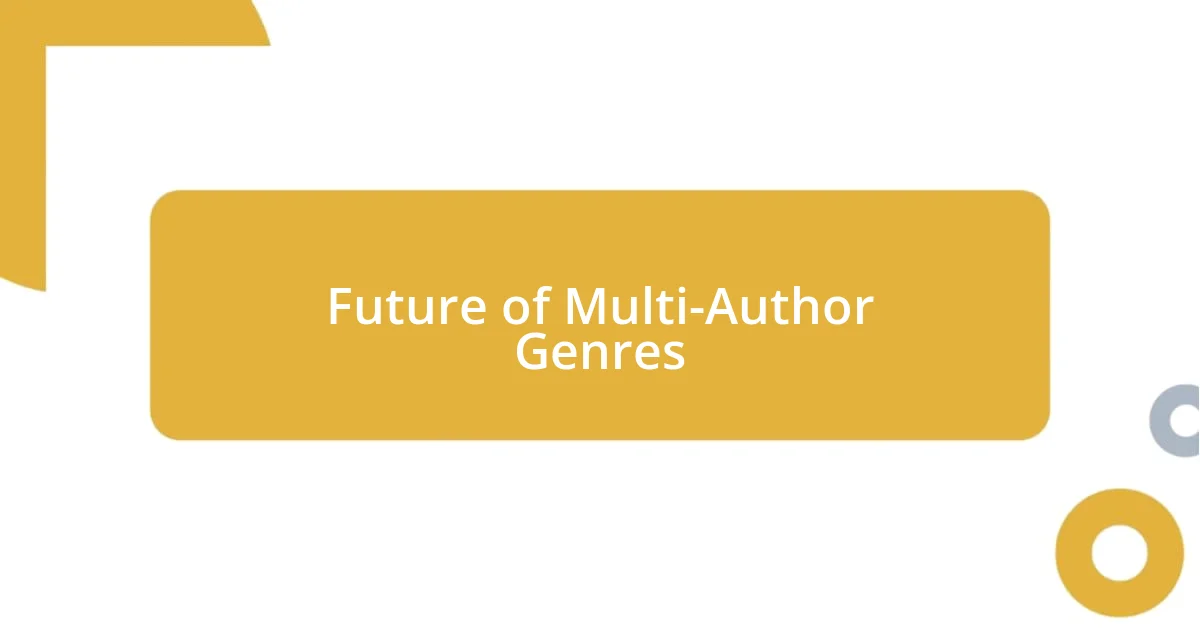
Future of Multi-Author Genres
Thinking about the future of multi-author genres, I can’t help but feel excited about the evolution we might see in collaborative storytelling. Recently, I participated in a project where different authors infused their cultural backgrounds into a shared narrative. This blending resulted in a richer storyline that resonated with a broader audience. Isn’t it thrilling to consider how diverse perspectives can shape the stories we tell?
I also believe that technology will play a pivotal role in how these collaborations unfold. Imagine using platforms that support real-time edits and discussions among authors! I can picture myself participating in virtual brainstorming sessions where we can tweak plot points on the fly. Isn’t that a game-changer for sustaining creativity and keeping the momentum going?
Moreover, the rise of reader involvement in the creative process fascinates me. I once experimented with a project where readers voted on character decisions. The feedback was overwhelming, and it created a sense of investment in the story. Could future collaborations also harness this idea, allowing fans to influence plots or character arcs? Engaging readers this way not only builds a loyal fanbase but also transforms them from passive consumers into active participants in the narrative journey.





